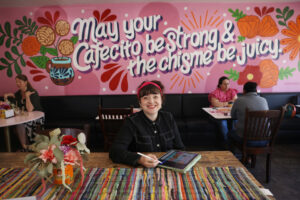
When it comes to public art, Sonoma County-based artist and graphic designer Blanca Molina goes big.
The post Maximalist Muralist Blanca Molina Spreads Color and Joy Throughout Sonoma County appeared first on Sonoma Magazine.
]]>
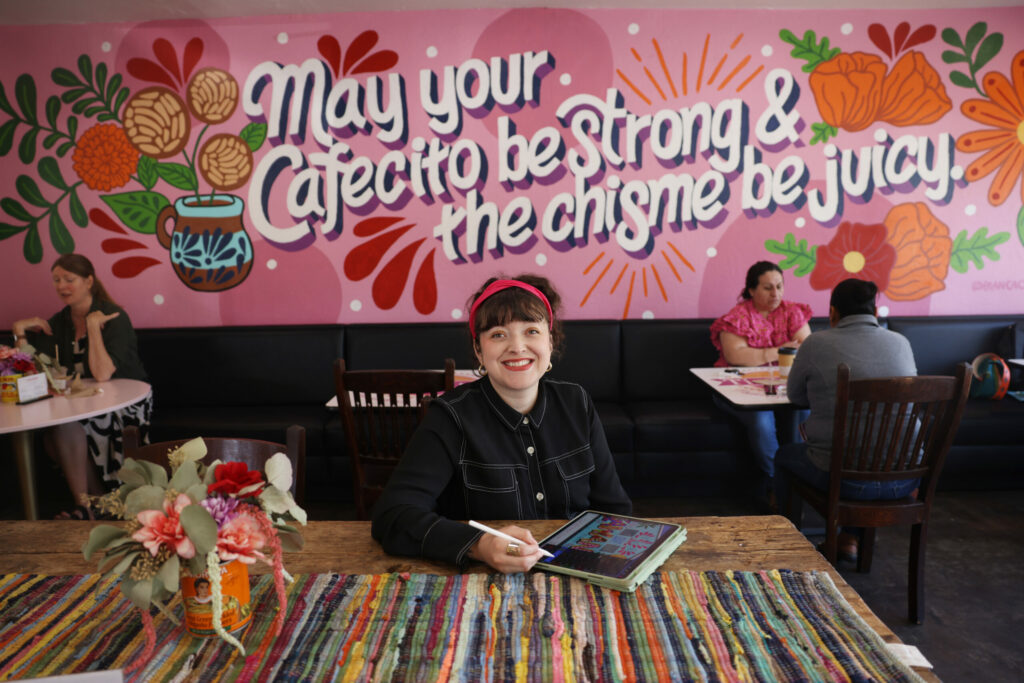
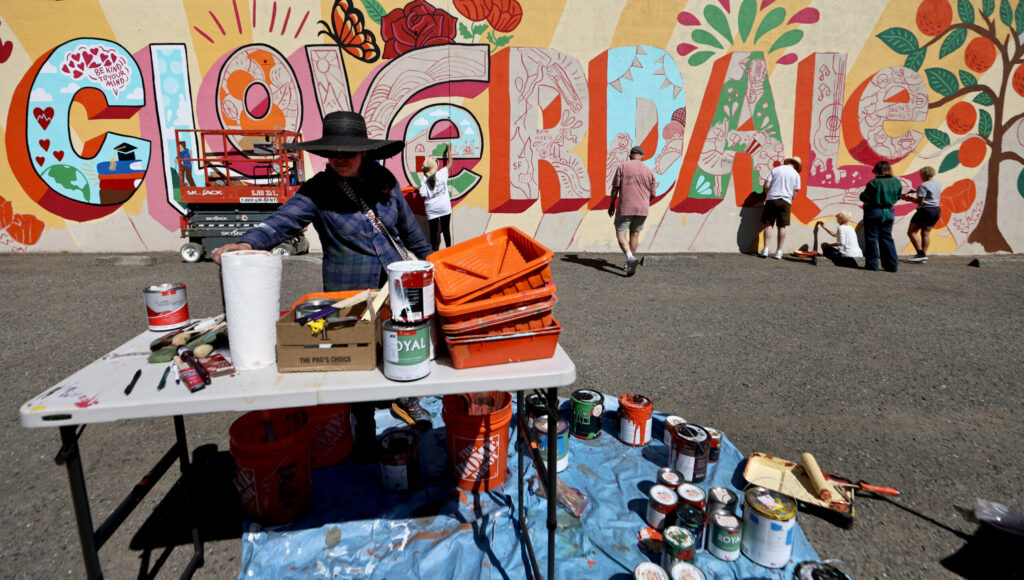
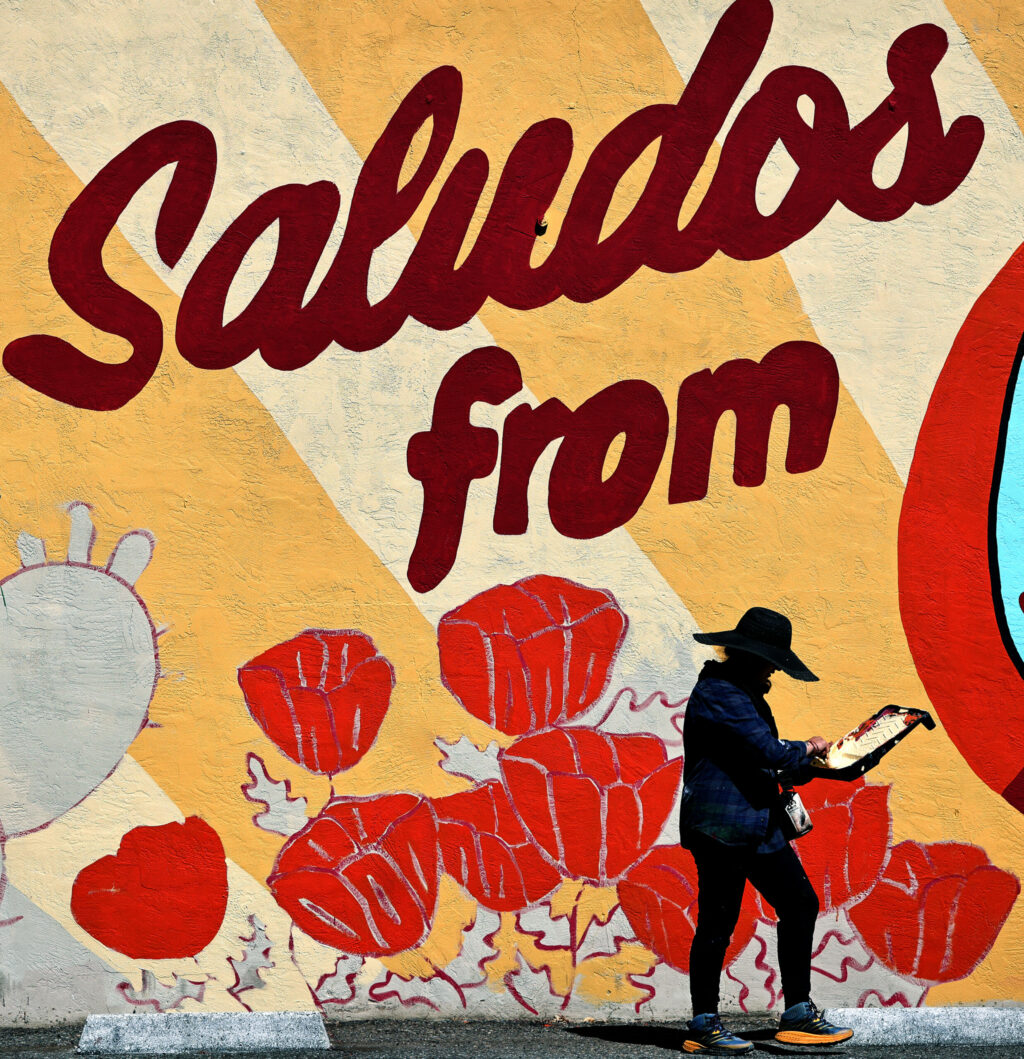

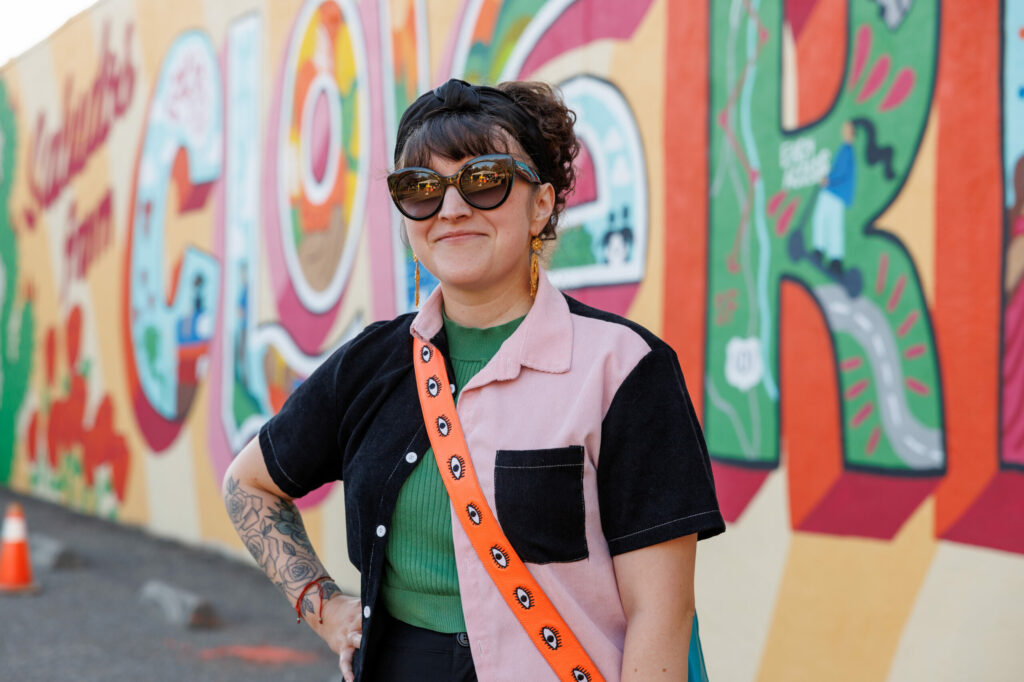
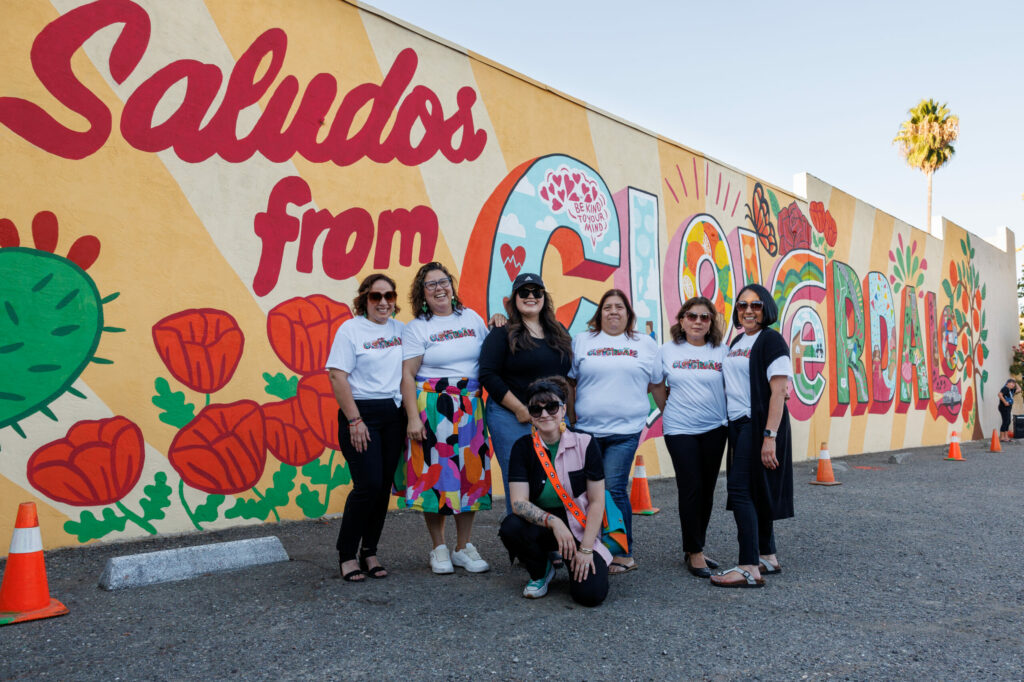

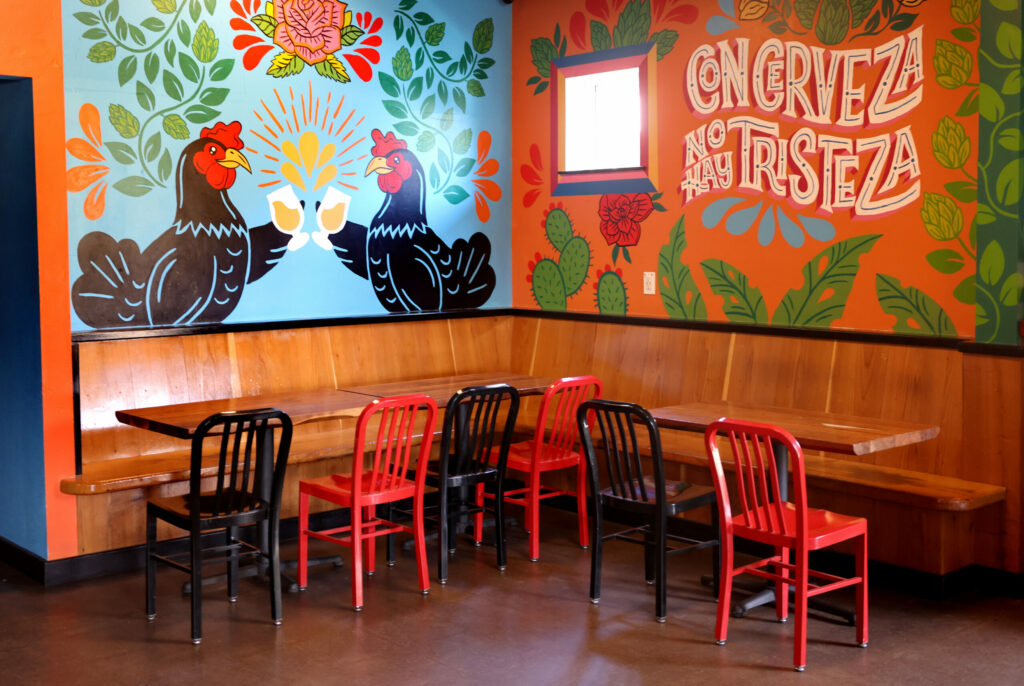
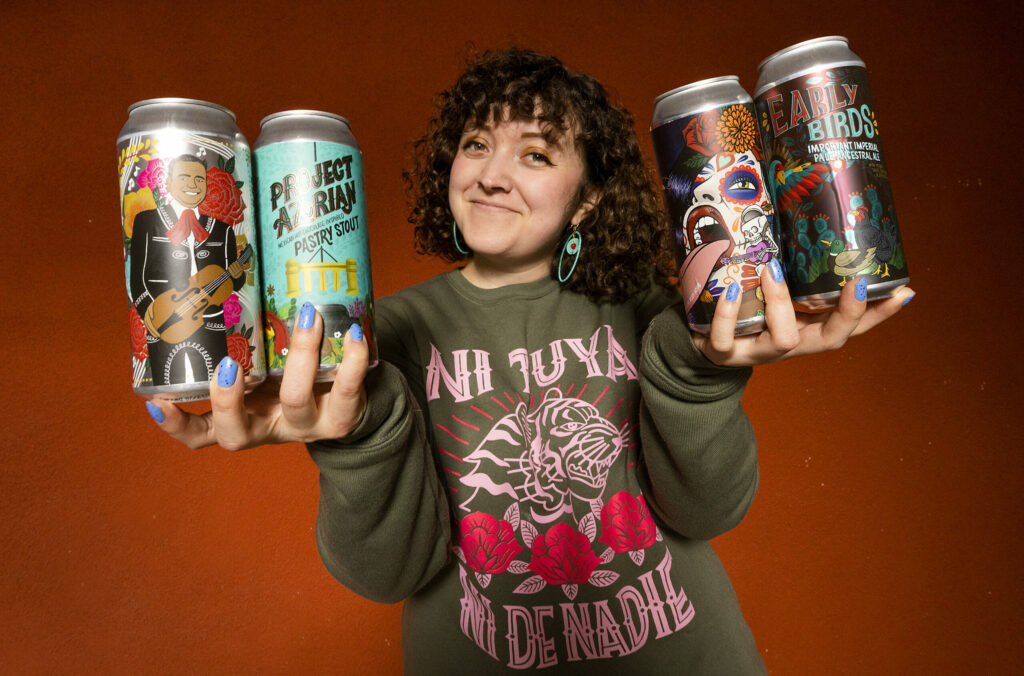
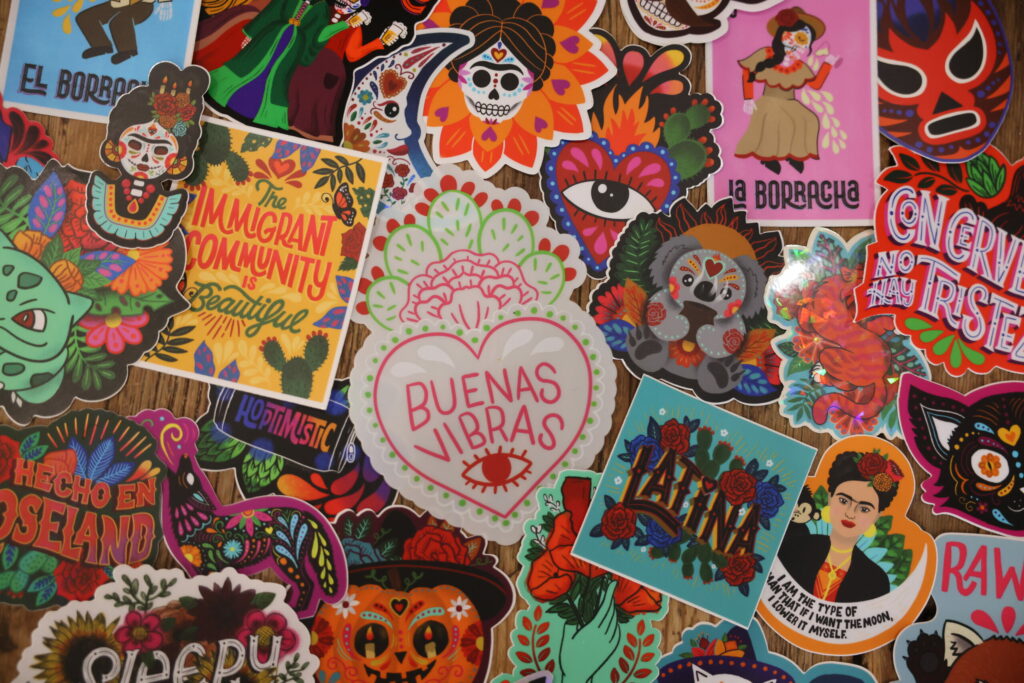
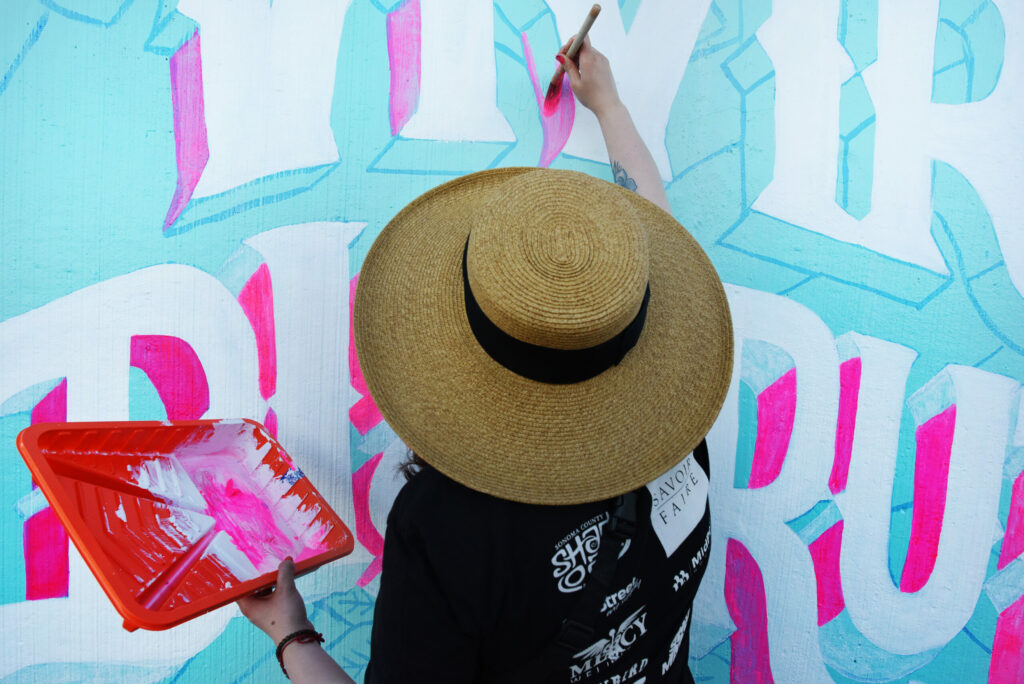
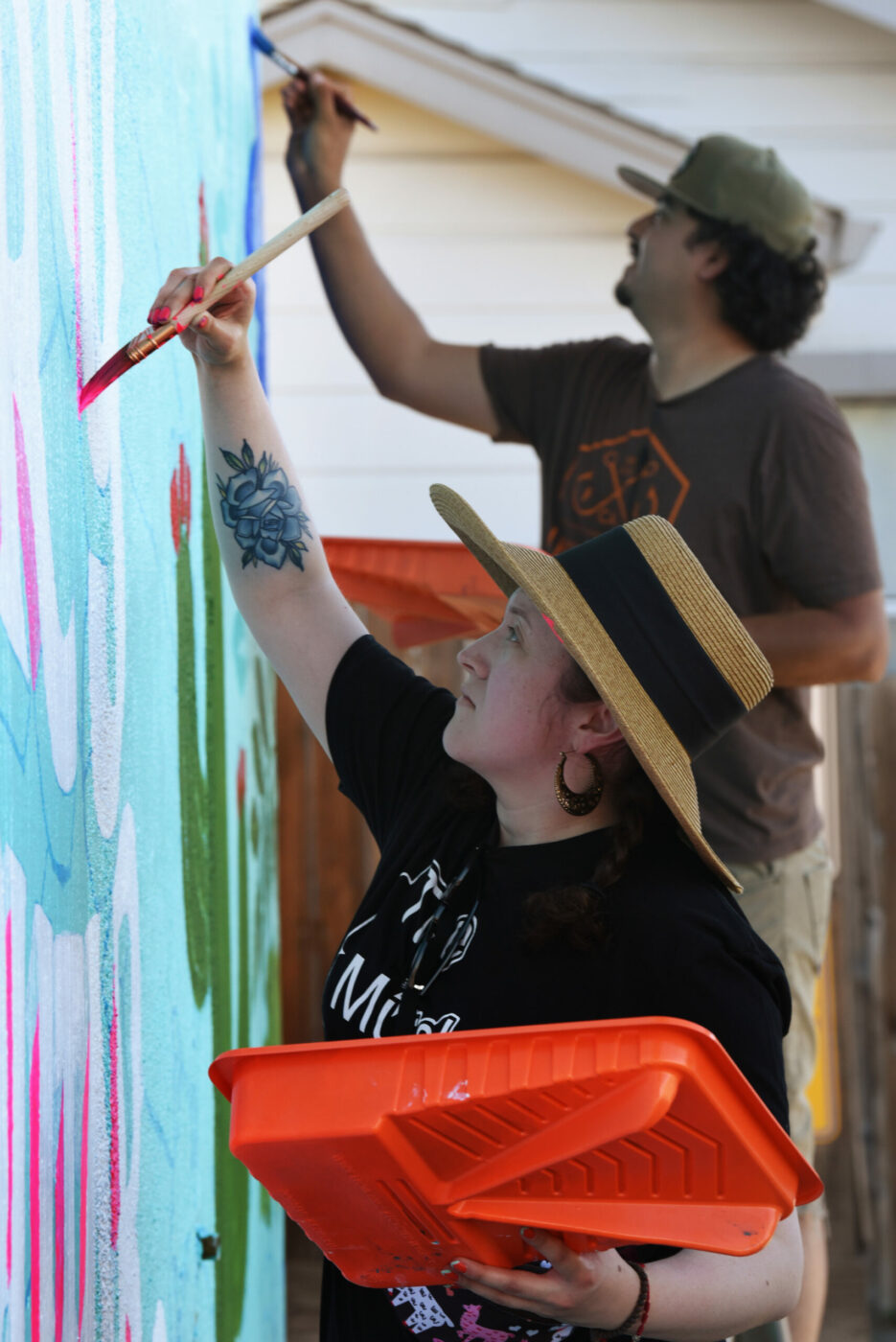
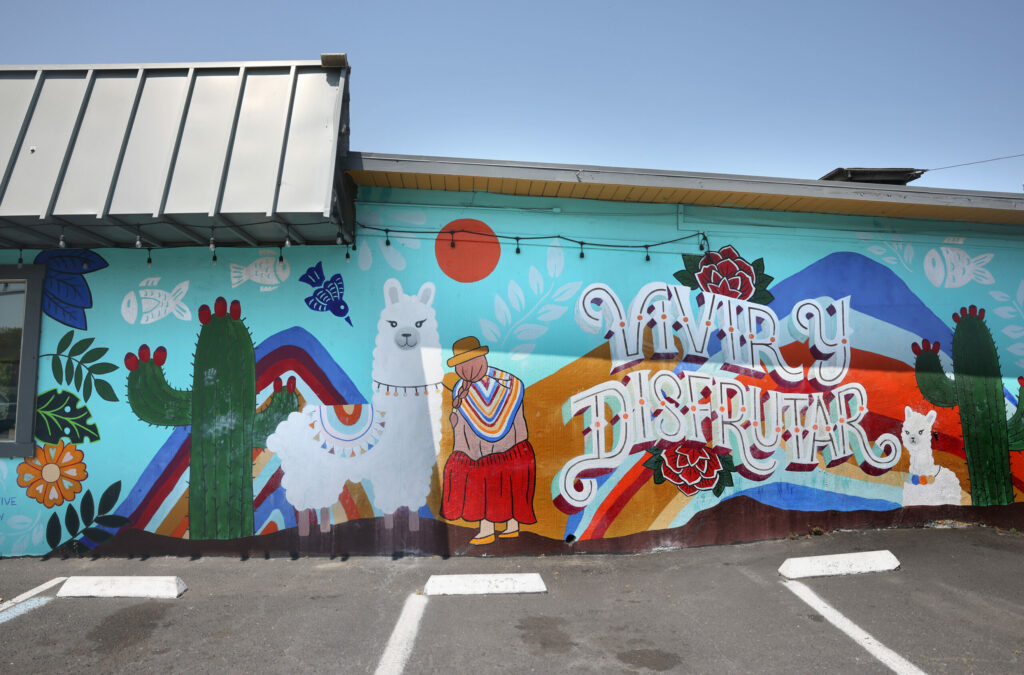
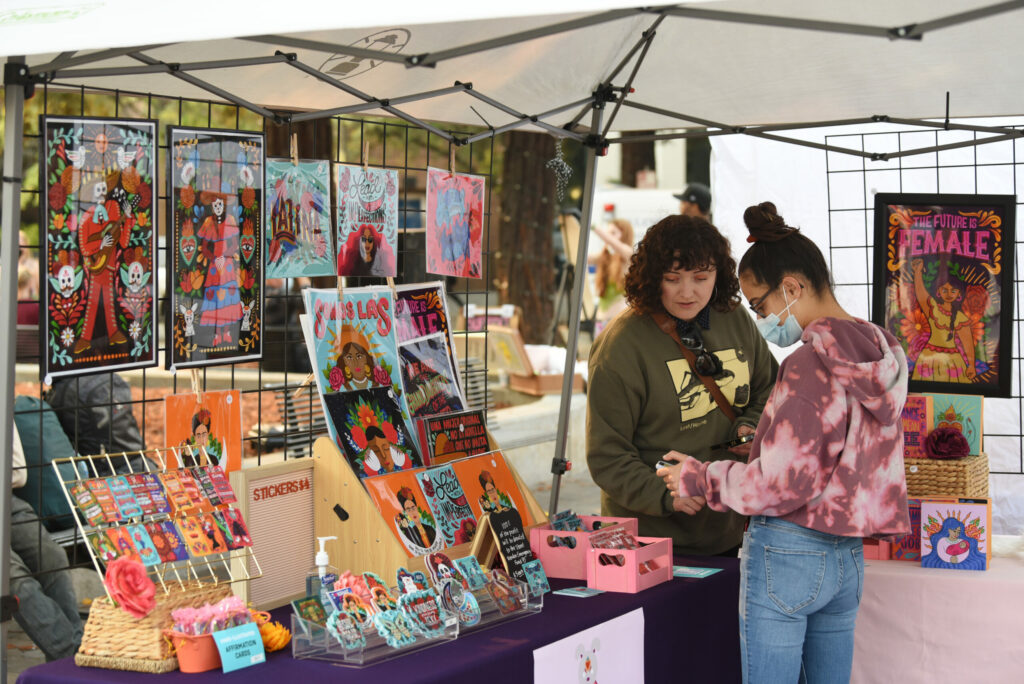
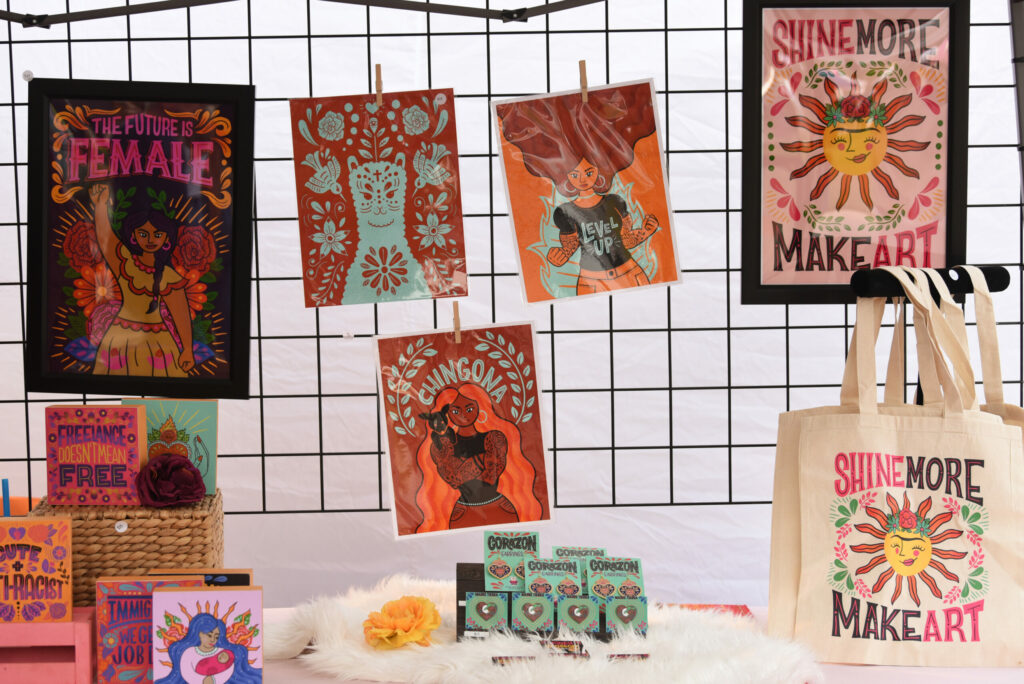
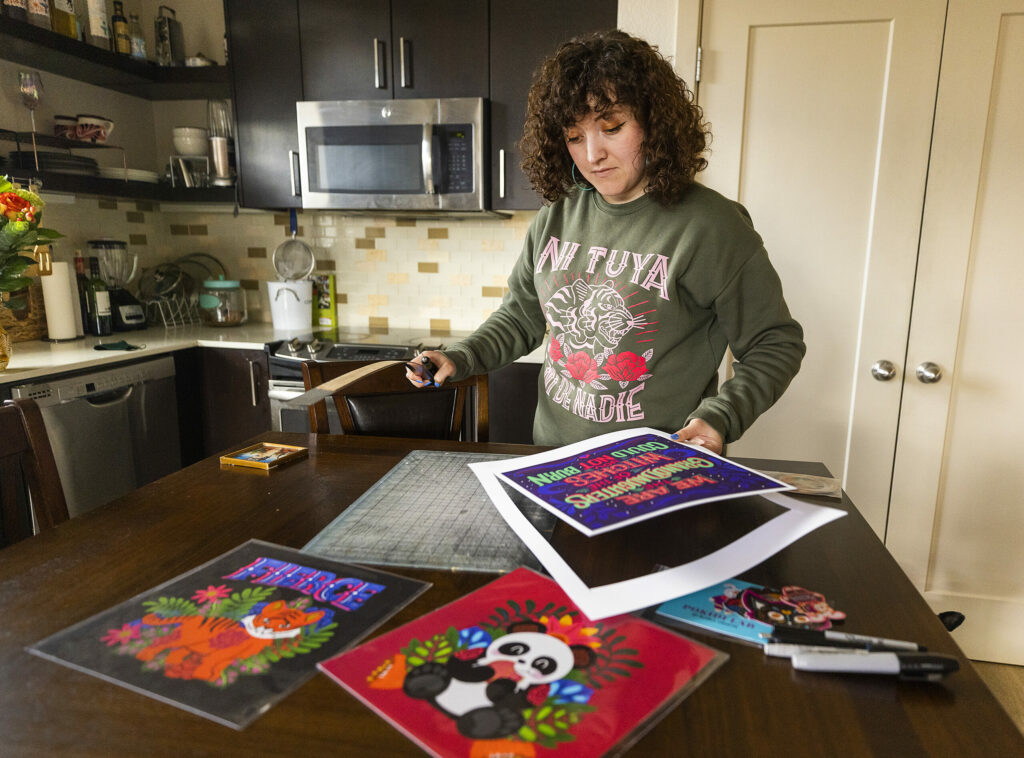
Blanca Molina sits in Tía María bakery in Santa Rosa’s Roseland neighborhood, studying her latest project on her iPad. At a table behind her, two women chat over cups of coffee, their conversation framed by a bright pink backdrop adorned with pops of orange florals and a bouquet of conchas sprouting from a café de olla that reads, “May your cafecitos be strong and your chisme be juicy.”
“Chisme means gossip,” explains Molina of the mural she created for the bakery this spring — one that might make you ponder: Does life imitate art, or does art imitate life?
For Molina, that philosophical question matters less than creating something that brings a smile to someone’s face. “Spreading joy and happiness with my art has always been my number one goal,” she says.
And she succeeds. Her creations are vibrant, bold, and lush. Describing herself as a “Latina maximalist,” Molina embraces a “more is more” approach. “I always want to add more pops of color, more movement. Make it busy, but clean. Organized chaos, I guess,” she explains.
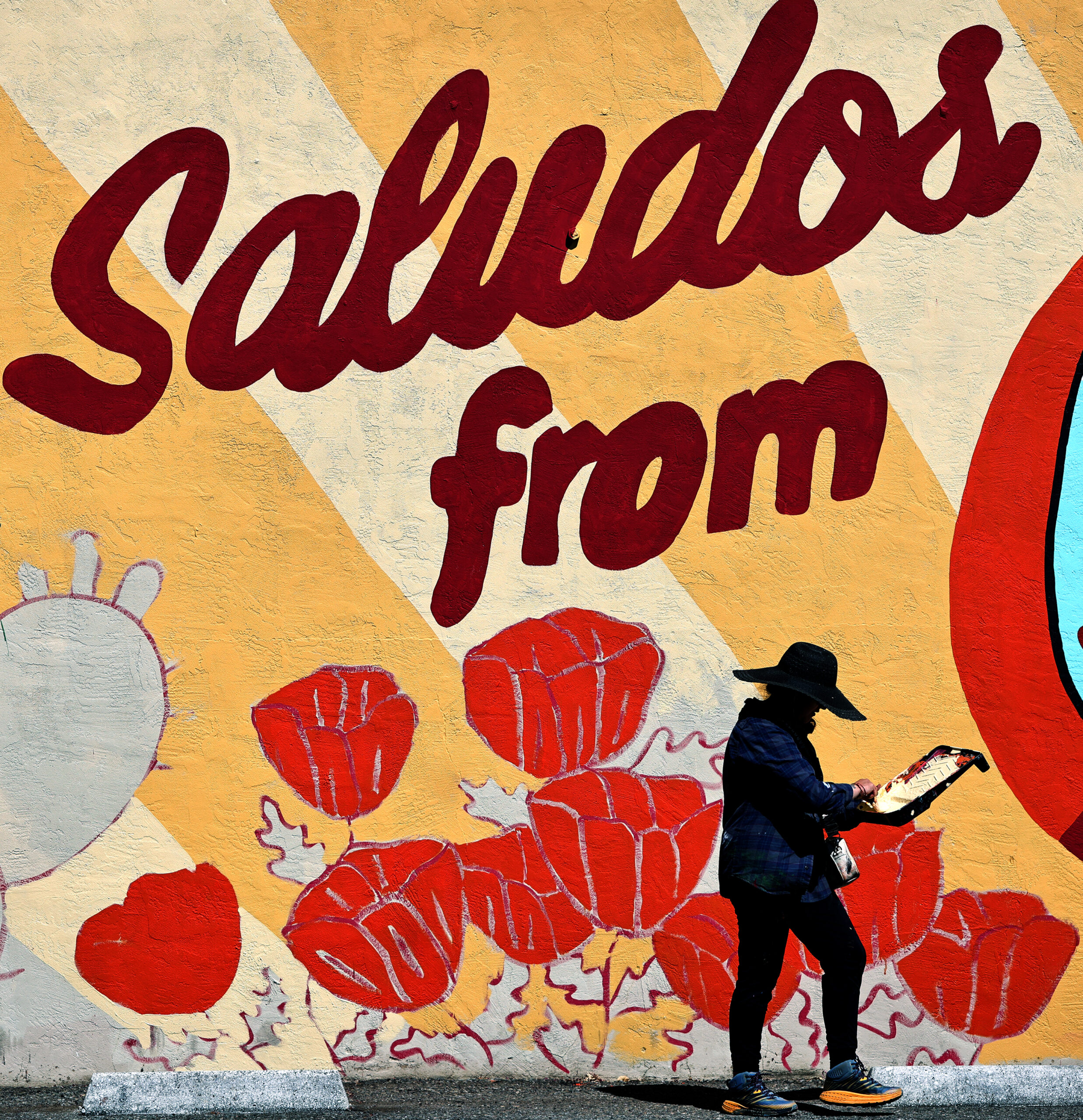
At its core, Molina’s art represents a yearning to capture the life her family left behind when they immigrated to California from Jalisco, Mexico, when she was 5 years old. “I kind of missed out on my culture by not being over there, so the only way I could connect to it is by drawing things that are important to the Mexican culture,” she says.
Molina is especially drawn to pink and orange hues, colors significant to Día de los Muertos, which also happens to be her busiest time of year. She recently completed a Día de los Muertos project for Lush Cosmetics, creating packaging that will be released this autumn.
The imagery of sugar skulls and brujas (witches) — inspired by the holiday — features prominently in her artwork and has brought her considerable attention. But her work also incorporates American influences. “I grew up here, so I do use a lot of Spanglish,” she says of her designs.
After her family settled in Napa, Molina, her parents, and her two siblings moved to a property in Alexander Valley where her father managed a vineyard. She worked at the nearby Jimtown Store during college and credits the store’s owner at the time, Carrie Brown, with influencing her artistic approach. “She’s very colorful in her way of putting foods together. It influenced my art down the line,” Molina recalls.
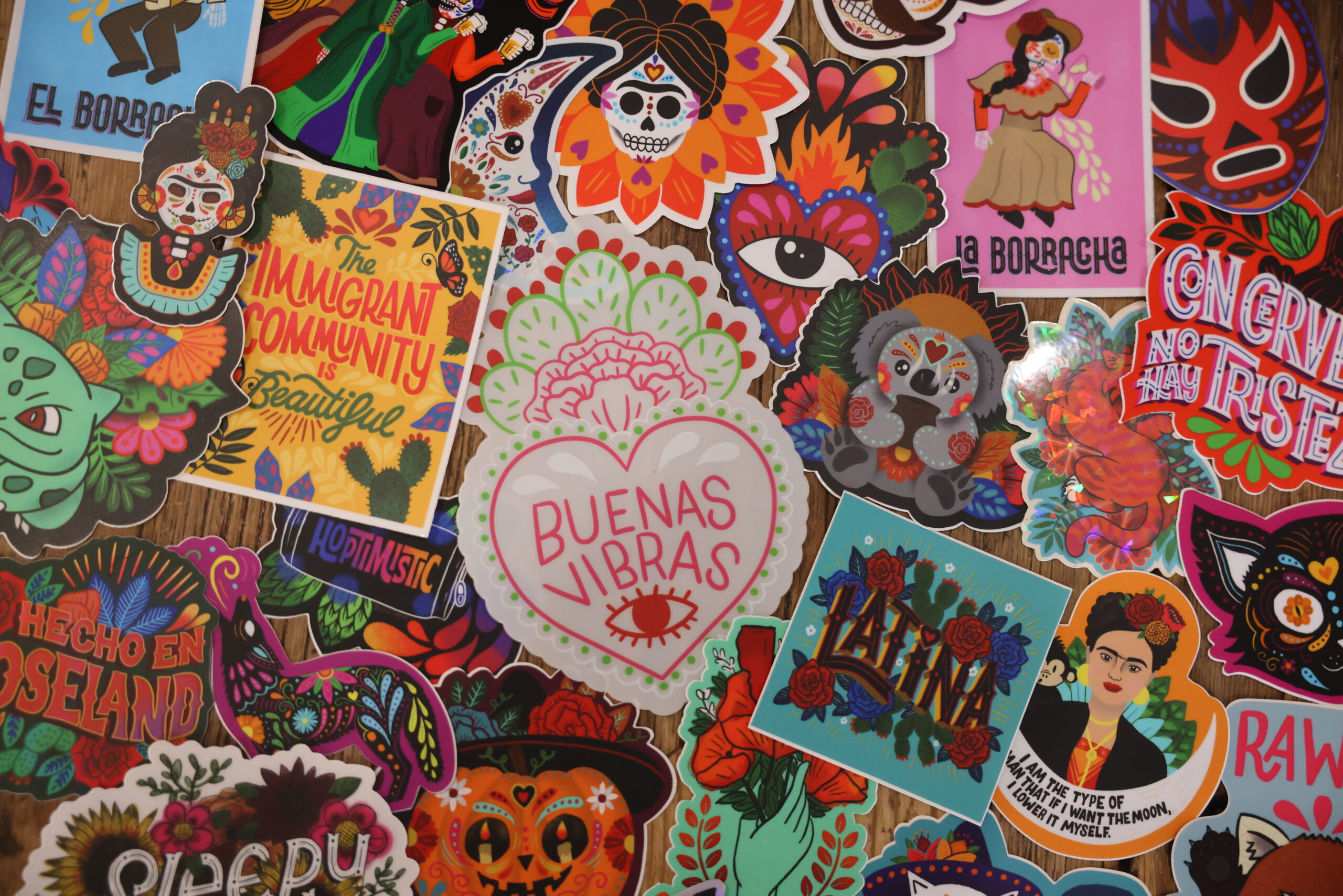
A career graphic designer, Molina learned early on, while a student at Healdsburg High School, that creativity can be a powerful tool for tackling tough topics. “Sometimes, the topics weren’t even that interesting to me, but I knew I had to do a poster and the poster made me more excited about it.” Some teachers even complimented her ability to make “boring” subjects more engaging.
Even now, with her use of vivid colors and joyful artwork, she manages to broach subjects like immigration, feminism, and self-actualization with a sense of humor — albeit with a subversive spin, but only in the nicest way possible. “I don’t like to say negative things, I like to spread positivity,” she says of her images with messages like “The immigration community is beautiful” and “The future is female.”
Molina’s message of joy and positivity flourishes for all to see in her artwork. Her murals, largely concentrated in the Roseland neighborhood, are public-facing art. In addition to the one at Tía María, another at nearby HenHouse Brewing reads, “con cerveza, no hay tristeza.” Molina says, “It sounds better in Spanish,” but translates it roughly to “with beer, there is no sadness.”


Her first design, “vivir y disfrutar,” painted in 2022 on the side of Sazón Peruvian restaurant, means simply to “live and enjoy life” — a reminder, perhaps, to the sometimes harried drivers on busy Sebastopol Road to slow down and take it easy.
Her newest mural design, debuting this summer, is mobile — a bus in Napa Valley will be fully wrapped in her artwork, incorporating, among other things, vineyards, a vineyard worker, and a woman holding a glass of wine on one side. On the other, orange poppies and the California bear appear — in this iteration, with a pair of monarch butterfly wings. (The bear on the California flag was inspired by a bear named “Monarch,” one of the last California grizzlies in captivity.)
Although all her murals are impressive, none are so precious as to be tucked away in an intimidating gallery or hushed museum. The medium is the message: This is art for everybody.
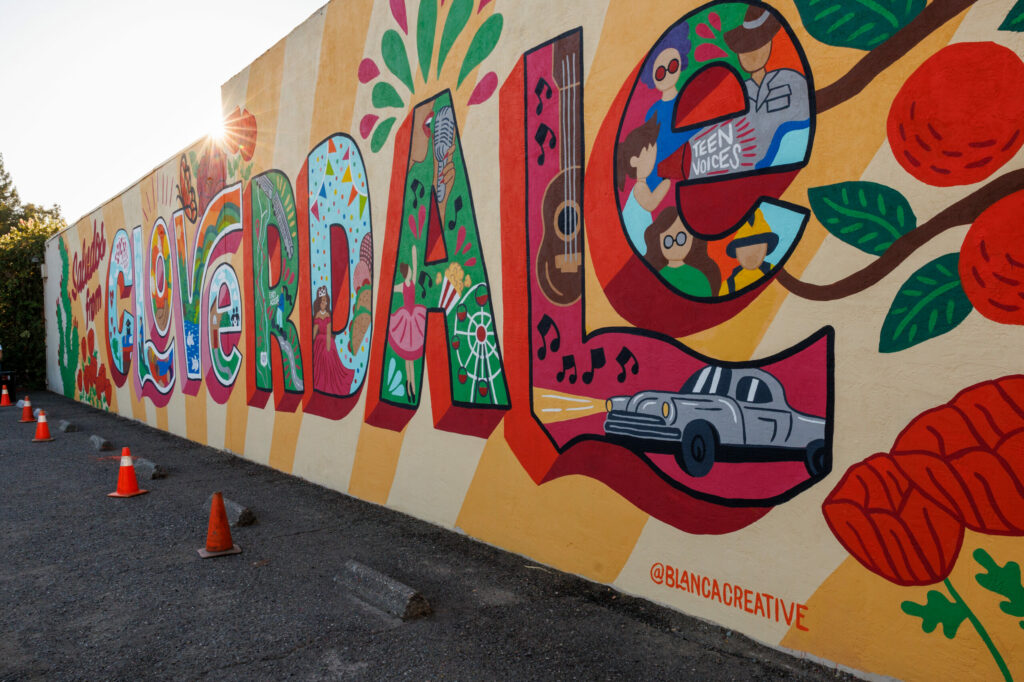
The mural in Molina’s new hometown, Cloverdale, which was unveiled last year, was a turning point for how she approaches projects. Through a series of meetings organized with Kimzin Creative, community members gave input about meaningful images to include. The themes they selected were incorporated into letters that spell out “Cloverdale” for a 60-foot mural on the side of the Encore Dance Theater on Cloverdale Boulevard.
To create a mural, Molina photographs the wall, then uses its exact dimensions for her design. In her home office, she creates a digital image on a computer with a giant screen that allows her to easily see her more detailed work.
When it’s time to turn virtual into reality, she uses a laptop to project the outline of her design onto the wall, then traces it, quickly, sometimes in chalk, sometimes with paint. For large projects, like the Cloverdale mural, she projects a quadrant at a time, carefully piecing it together.


When it came time to paint the Cloverdale mural, the community got to help — a first for Molina. She describes her work as a “very color-by-numbers kind of style,” which helps on projects where people bring varying degrees of artistic experience or, perhaps, none at all. But just because it’s easy to paint, it doesn’t mean it’s easy to design.
Creating the template, she says, is where the real work lies. “Coming up with something that other people can do, that’s where it gets tricky.” But for her, the work is worth it because that collaboration allows people to experience a deeper connection to the art. “People would go to the flower they painted, and they’ll show their family, ‘Oh, I painted that flower.’”
Now, when a business or organization asks her to create a mural, she encourages them to consider involving others. “If you bring customers in (to help), they’ll become even more loyal customers,” she says. “It’s just a beautiful feeling. It brings more positivity to that business.”
Living so close to the Cloverdale mural, Molina finds a lot of satisfaction seeing people — including city council members — take photos in front of it. “It’s like a warm hug.”
Follow on Instagram @blancacreative. blancacreative.com
Find Molina’s murals, along with murals from other local artists, scattered all around Sonoma County.
The post Maximalist Muralist Blanca Molina Spreads Color and Joy Throughout Sonoma County appeared first on Sonoma Magazine.
]]>
"George Floyd and Breonna Taylor, the countless others. That gave the energy for the series," said Orin Carpenter of his new collection of mixed-media artwork.
The post ‘In Danger Species’: Petaluma Artist Portrays Black American Experience appeared first on Sonoma Magazine.
]]>
















As Orin Carpenter tells it, his art career began at age 5, with painting on walls. He and his mother had just returned from the library, and he needed to paint. “This was one of those days where I ran out of paper. I was like, ‘You know what? I gotta get this out.’” Seeing the white wall, he couldn’t resist.
Carpenter’s interests have led him from his native Memphis to the Bay Area, from graphic design into a career as an artist and educator. Today, he’s a whirl of activity: teaching art at Marin Catholic, completing a doctorate in educational technology, leading workshops on art and racial justice, and, of course, making art in his studio.
Recently, he’s been immersed in two series: “Quarantine State of Mind,” abstract paintings navigating this past year, and “In Danger Species,” mixed-media meditations on the experience of living while Black in America. Carpenter had been marinating on the ideas behind the latter for some time. Then last year, when Ahmaud Arbery was killed in Georgia, “I said, ‘You know what? I can’t sit on this anymore. I have to create.’ It was more for me to express and have an outlet from the anger, you know? George Floyd and Breonna Taylor, the countless others. That gave the energy for that series.”
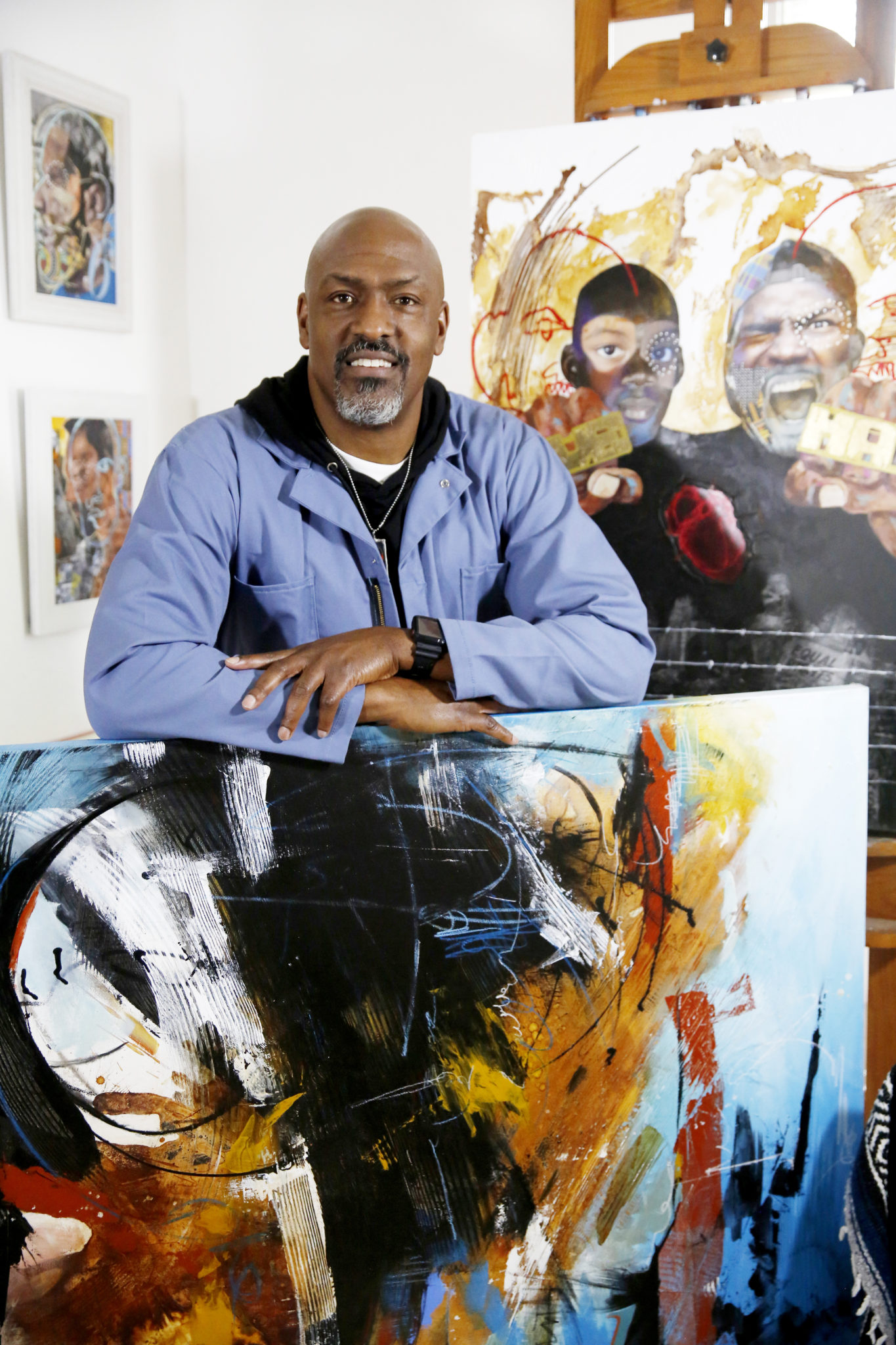
Carpenter has just been named an artist in residence at MarinMOCA, where he’ll have a solo exhibit this December, and shows his work at the Artize Gallery in Palm Springs. Carpenter has been sheltering-in-place — and teaching high school art remotely — from Petaluma, where he lives with his wife Mickele, son Kaleb, daughter Kyndall, and the family’s two rescue cats, Lando and Phasma.
Here’s how artist Orin Carpenter spends a day. (This is from a Sonoma Magazine series “A day with …” in which we follow local people doing interesting work in Sonoma County).
4:30 a.m. I’m an early riser. I usually wake up anywhere from 4 to 5. Once I get up, being a Christian, I pray and read devotion and kind of start the day.
6:00 a.m. Sometimes I start working here, with my sketches. Then I have to get out of the space, and being outside is a refresher for me.
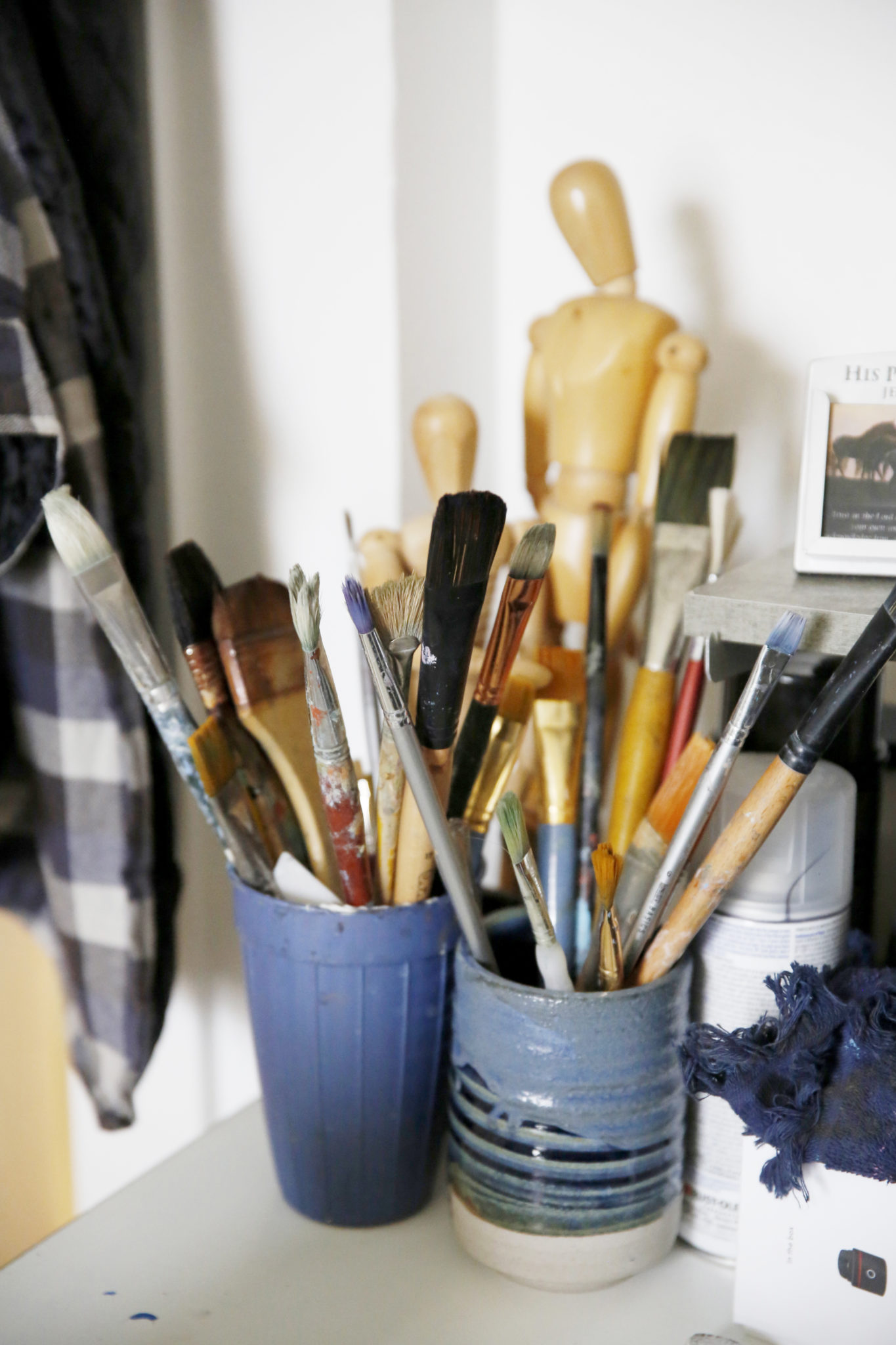
7:00 a.m. Early on a weekend morning, when it’s quiet, I’ll wander around downtown Petaluma, kind of meditate, sketch there. I’ll go to Starbucks, get a white chocolate mocha, and maybe a chocolate croissant. (I mean, might as well overdo it with the chocolate!) Then I visit Brian’s Comics. And I don’t care how old you are — you feel like a kid when you walk in the place. I love going there; chatting with Brian about movies, books, writing; and then, of course, buying comic books. It just revives that energy — it reminds me of being a little boy going into the library.
10:00 a.m. I come home, start looking at notes. Right now, I’m working on concepts for some landscapes. I travel a lot with my family, and one of our favorite spots is Italy. I want to revisit Menaggio, because I just love the feel there. It’s funny, because I actually called it “home.” There’s something about it that’s comforting. So, I think of words that kind of go with “home” and Menaggio, start thinking about the color palettes there. I take photos and look at the color schemes and things that were there, and see if I connect with those, and, if so, are those the pieces and colors I want to put in my piece? Then I start playing with the values of those colors, kind of mapping out that series.
1:30 p.m. Because I’m painting, I create lunch here, to take a break and come back and paint. My wife and I joke about Italy. We do our rocket lettuce salad with Gorgonzola cheese and balsamic dressing and glaze, with candied pecans.
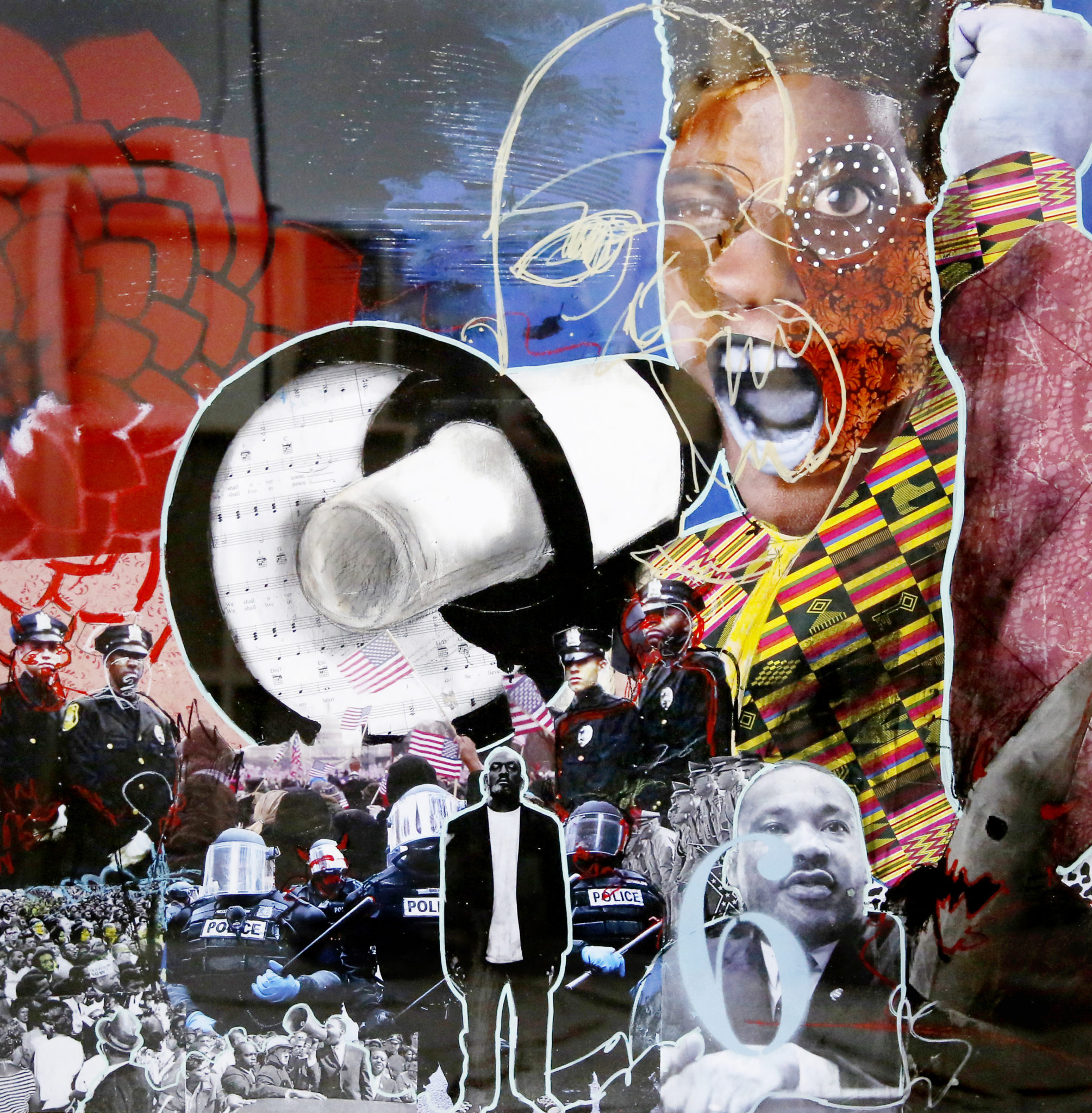
2:30 p.m. I have another virtual workshop coming up, where we actually use art as a vehicle to have these uncomfortable conversations, dealing with racial injustice. I like to be overprepared, so I make sure all the technical aspects are done, do a test run, and think about trouble spots, how to maneuver through that.
6:00 p.m. The family, we love trying restaurants. I think that’s the beauty of Northern California — you can find great places. La Rosa in Santa Rosa is our top one (500 Fourth St., 707-523-3663). Their carne asada is good, the risotto relleno is good, and the tequila shrimp is one of my favorites. I’ll get something and Mickele will get something, and we’ll try things out.
8:30 p.m. At night, it’s kind of doing a checklist: making sure I had a good stopping point for the creative work I’m doing, seeing if there are other materials I need — making sure I have all the elements, so when I continue to work on it, it doesn’t interrupt the flow. Emails go out for school and my PhD work. Kind of shutting everything down, making sure everything has been taken care of before I can go to sleep.
To see more of Petaluma artist Otis Carpenter’s recent work, visit orincarpenter.com
The post ‘In Danger Species’: Petaluma Artist Portrays Black American Experience appeared first on Sonoma Magazine.
]]>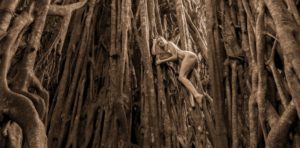
Julianne Skai Arbor, a.k.a TreeGirl, poses nude and intertwined with different kinds of trees.
The post Sebastopol Artist Takes Nude Photos With Trees in 13 Countries appeared first on Sonoma Magazine.
]]>
















It’s the grand, exotic trees that especially call to Julianne Skai Arbor — the ones with gnarled outgrowths, tangled roots or hollows into which she can crawl.
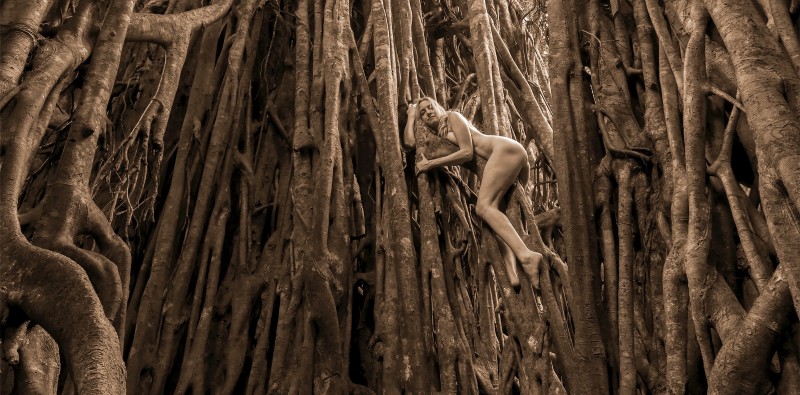
She likes to drape herself across swooping branches or ease herself into small spaces, exploring the habits, curves and textures of the different species she seeks out around the globe and absorbing their life force.
The Sebastopol resident’s affection for the trees of the world has evolved into a unique vocation, one that forms the basis of a new coffee table book that features photographs of the author posing nude, enmeshed or intertwined in some way with different kinds of trees. Most of the photos are shot by Arbor with a remote control and tripod, although she occasionally enlists the help of a friend or guide.
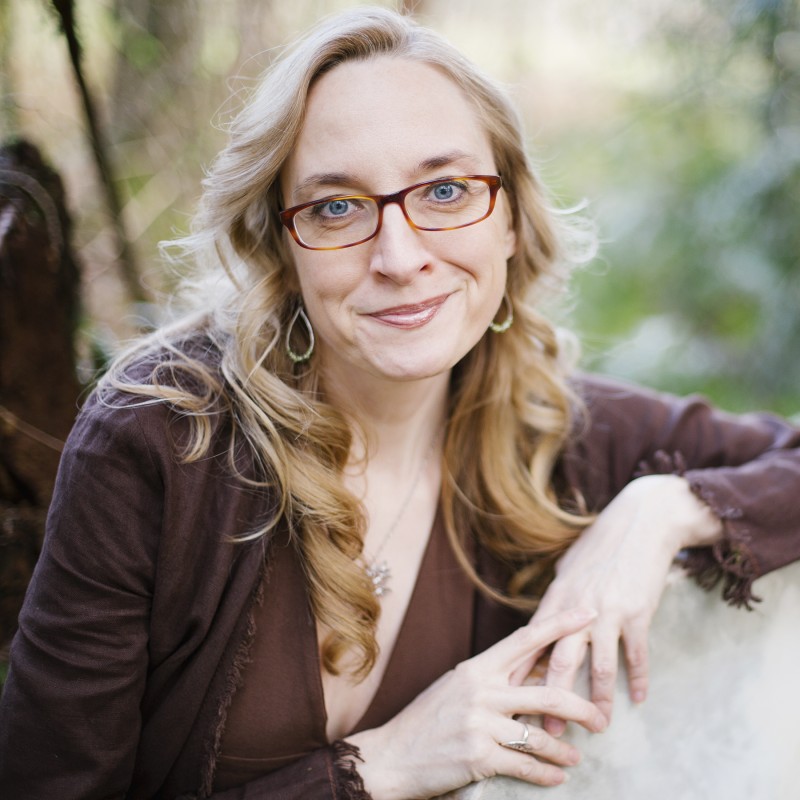
A certified arborist and environmental educator, Arbor espouses intimate engagement with trees as a kind of extreme ecotherapy, a spiritual reconnection with the natural world that is both healing and fundamental.
“This book is really an invitation for people to have relationship with more than just humans,” says Arbor. “I’m opening up the possibility.”
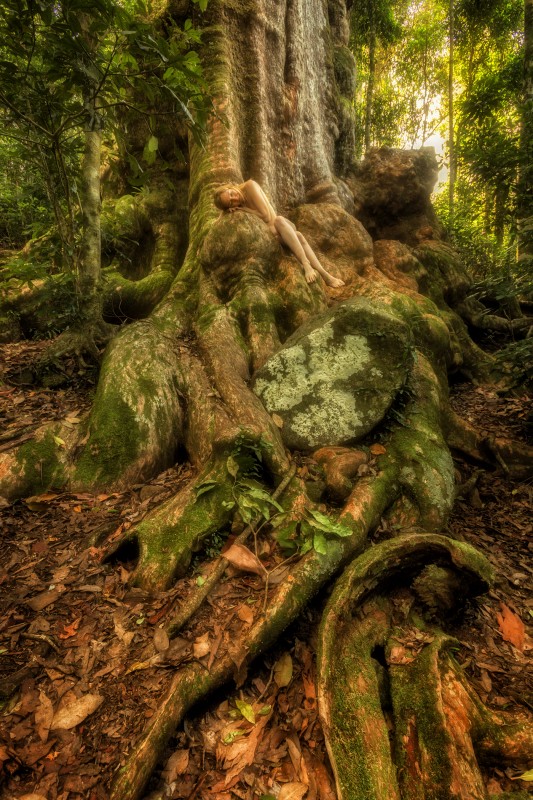
“TreeGirl: Intimate Encounters With Wild Nature” includes images from some of Arbor’s more than 70 rendezvous with trees in 13 countries on four continents, shot over a period of some 20 years. The 200-page volume includes essays detailing different aspects of the author’s connection with trees.
Arbor says she found her own magic in the big, backyard trees of her childhood in suburban Chicago. But she was in her 20s, a student of art and ecology freshly arrived in California for graduate school, when the majesty and grandeur of the state’s redwoods and sequoias sparked a thirst to understand more about them.
“Once you get to know a species, then it becomes your friend,” she says. “‘Oh! Hi, Redwood! I know you.’”
Julianne Skai Arbor will appear at Copperfield’s Books for a talk and book signing at 7 p.m. on Earth Day, Saturday, April 22. 775 Village Court, Montgomery Village, Santa Rosa. treegirl.org
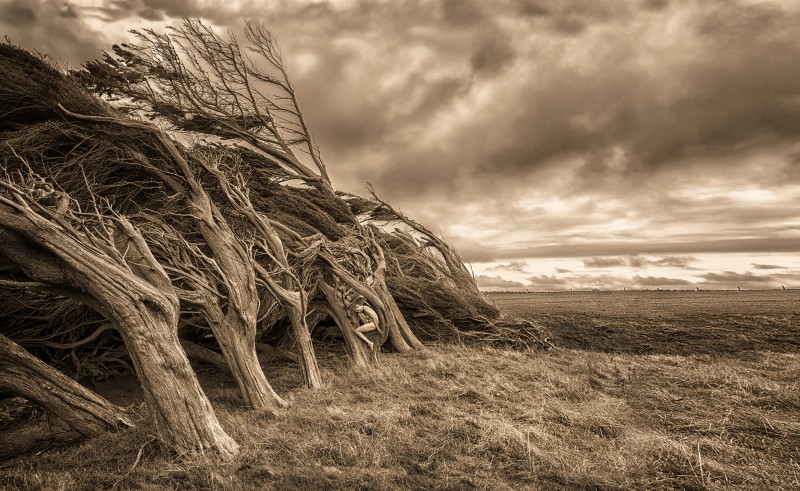
The post Sebastopol Artist Takes Nude Photos With Trees in 13 Countries appeared first on Sonoma Magazine.
]]>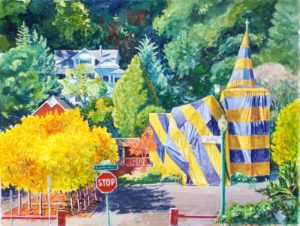
William “Bill” Taylor’s renderings of the West County urban landscape have remained unseen and unrecognized for five decades. They are now being revealed and celebrated in a series of local exhibits.
The post Santa Rosa Artist’s Work, Unseen for Decades, is Revealed and Celebrated in Local Exhibits appeared first on Sonoma Magazine.
]]>
















William F. Taylor paints for the love of painting. He paints the way a Zen practitioner meditates, the way a musician composes: as a daily creative practice. Now 89, the shy and nearly deaf Santa Rosa artist has painted almost every day of his adult life, yet never sought to make himself known.
His art was virtually unseen until last fall, when the Sebastopol Center for the Arts, supported by RiskPress Foundation, gave him a solo exhibition. A major group of his paintings of Occidental and its environs is featured in a three-man show opening January 20 at the Occidental Center for the Arts.
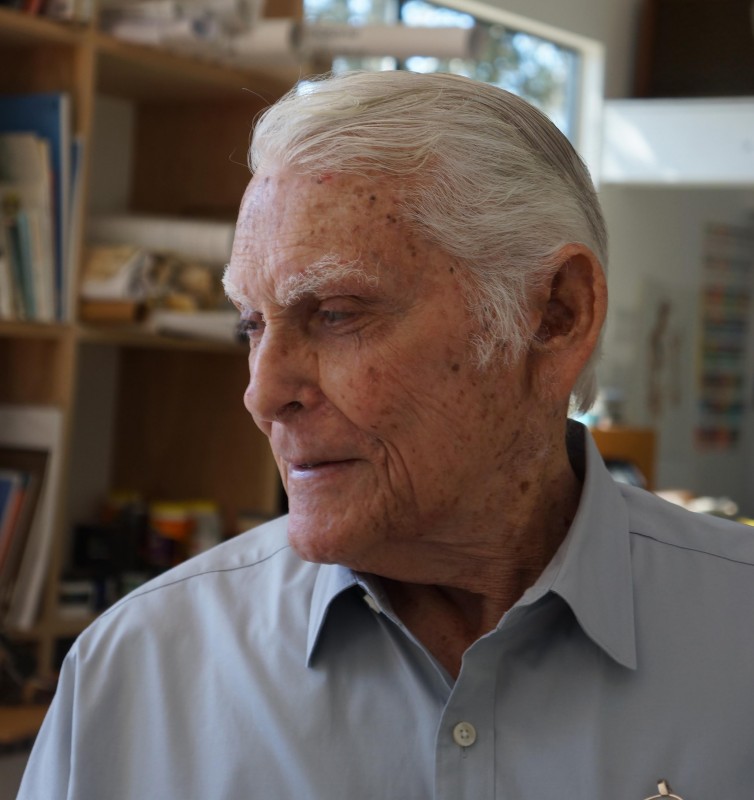 Bill Taylor’s subject matter is the urban landscape.
Bill Taylor’s subject matter is the urban landscape.
He paints seated in his car in front of the subject he has chosen. (He likes the mobility and privacy.) A master draftsman who worked as a graphic artist for two decades in Los Angeles, he draws and paints precisely and at leisure (if he’s not asked to park elsewhere), working in watercolor, pen and ink, acrylics or oils.
When he can’t finish on the spot, he will develop the painting further at home.
Taylor may know Occidental more intimately than anyone alive. For decades he has studied its historic structures and verdant setting, its plays of light and color, its small shifts and transitions. Through the mindful act of painting, he reveals how deeply attached he is to the place. Iconic buildings such as St. Philip the Apostle Church, rendered from different angles at different times of the year (once, shrouded in a striped tent during termite extermination), pop up frequently, like old friends.
His straightforward and elegant images suggest a depth of understanding that can only come from a lifetime of practice. “Their intimacy is compounded and magnified because of the insularity of his deafness,” says his friend Charlie Pendergast of RiskPress. “His paintings are vivid evidence of meticulous insight.”
When he was younger, Taylor learned taxidermy and prepared bird specimens of such high quality that the California Academy of Sciences accessioned them for their collections. His paintings similarly preserve what is beautiful and unique in the region he loves.
“Onsite: Landscapes by Charles Beck, Dave Gordon and Bill Taylor” is on view at Occidental Center for the Arts January 20 through March 13, with an opening reception January 21, 4–7 p.m.
The post Santa Rosa Artist’s Work, Unseen for Decades, is Revealed and Celebrated in Local Exhibits appeared first on Sonoma Magazine.
]]>
When do used auto parts become art? When they’re in the hands of James Selby.
The post A Scrap Metal Saga: The Automotive Machinist Who Became an Artist appeared first on Sonoma Magazine.
]]>
















When do used auto parts become art? When they’re in the hands of James Selby.
Selby spent 35 years as an automotive machinist before turning artist, opening a studio in Santa Rosa to create sculptures from scrap metal. At 50, his fascination with old metal gears and parts led him to take a beginning welding course at Santa Rosa Junior College, where he discovered how to use his love of art and metal through sculpture.
Using a piece of soapstone, Selby begins by sketching an idea onto his “chalkboard,” a 4-by-8-foot metal table. He then lays coils, gears and other metal scraps onto the design and welds them into whimsical pieces that resemble people and animals. Ninety-nine percent of his metal is donated by friends and strangers.
In 2002, he first took his works to the Windsor Certified Farmers Market, selling everything in two weeks. He went on to a juried fine-arts show, winning first place. Now 63, Selby is a full-time artist, welding more than 50 sculptures a year and selling them or $150 to $3,500. Many pieces are donated to local nonprofits.
Selby’s public sculptures can be seen in Windsor at the Community Development office and at Fire Station No. 1, and in Santa Rosa at the Woodenhead Vintners tasting room, Worth Our Weight culinary program and Steele Lane Elementary School.
Selby Scrap Metal Design is open by appointment. Selby also offers metal-design workshops there, where participants design their own sculpture and leave with a finished piece ($250 or a half day, $500 or a full day).
“I hope my work inspires others to be creative,” he said. “My greatest joy comes from my workshops, where participants discover the artist in themselves.”
47 Foley St., Santa Rosa, 707-484-1598, selbydesign.com.
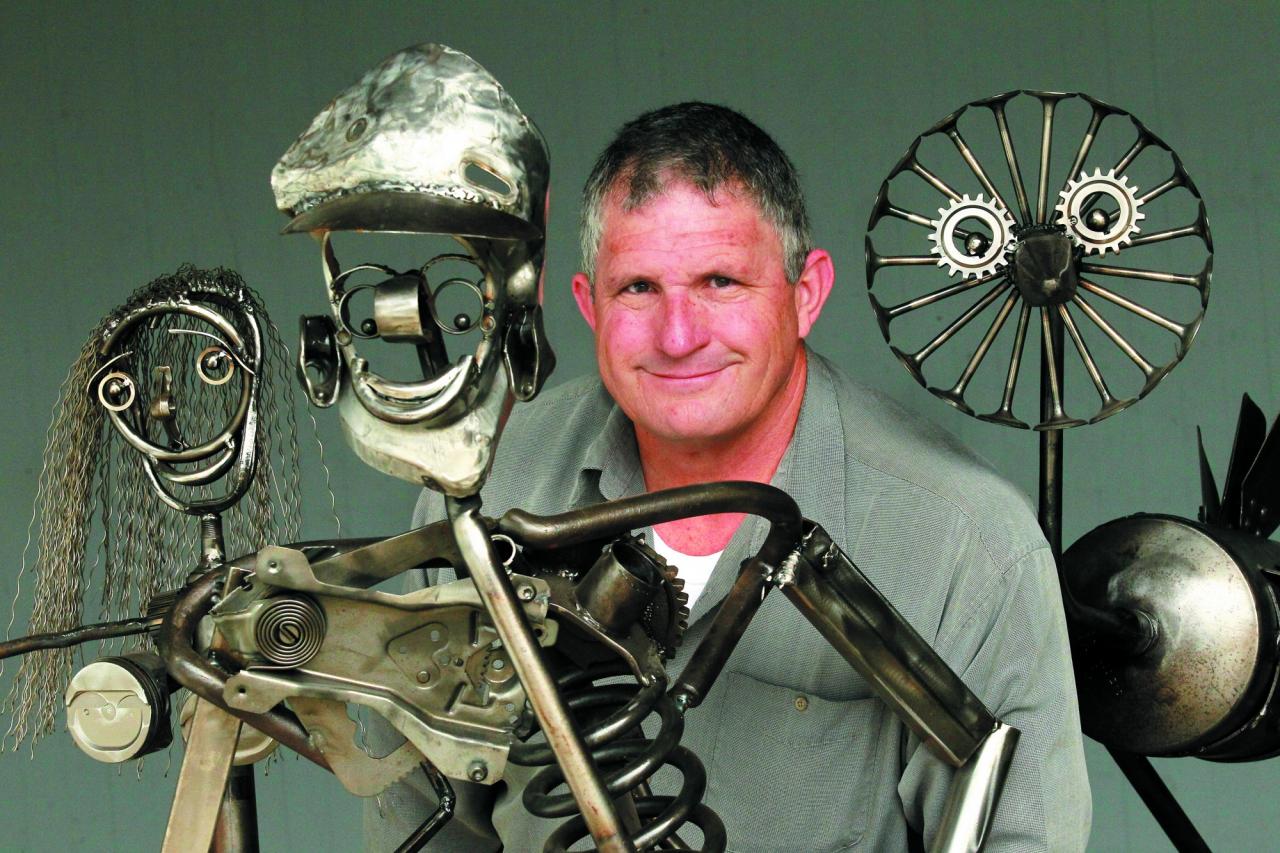
The post A Scrap Metal Saga: The Automotive Machinist Who Became an Artist appeared first on Sonoma Magazine.
]]>
We asked local arts guru and event coordinator Spring Maxfield to name the people she'd most want to have dinner with. See who she picked...
The post Who Are Your Dream Sonoma County Dinner Guests? appeared first on Sonoma Magazine.
]]>
















 Spring Maxfield is a curator, event planner and supporter of all things art. Hyperconnected yet not at all into self-promotion, she would rather tout an emerging Sonoma artist than her own work.
Spring Maxfield is a curator, event planner and supporter of all things art. Hyperconnected yet not at all into self-promotion, she would rather tout an emerging Sonoma artist than her own work.
Her degree in art history and art practice and master’s in museum studies attest to her abiding interest in art. The Santa Rosan, who is married to ceramic artist Todd Baricklow, has added vibrancy and creativity to the Sonoma arts scene, staging underground gallery shows, co-founding the Great Handcar Regatta festival in 2008 (which at its peak drew 20,000 participants), and serving on numerous art foundation committees.
In late 2015, Maxfield joined two other Sonomans in working for three weeks at Syrian refugee camps on the Greek island of Lesbos. She hugged kids, delivered supplies, handed out shoes and made 1,200 cheese sandwiches on one day — anything to offer relief to those who fled the furious fighting in Syria. So it’s not surprising that Maxfield, when asked about who she would invite to dinner, said: “While dining with people is lovely, what I really want to do is see people in action. What makes them tick, what motivates their work? It is incredibly hard to narrow the list down to just three Sonoma crushes, as there are so many hidden gems and people who are following their passion with such intensity that they radiate creative energy.”
When pressed, she chose these women.
 “I would definitely have dinner with Amanda Janik. Watching a writer work is probably not as interesting as talking to one. But judging by her writing, she would definitely be hilarious. I’ve seen her stand-up comedy at the Mortified North Bay show in 2015 and other venues, and have never laughed so hard.”
“I would definitely have dinner with Amanda Janik. Watching a writer work is probably not as interesting as talking to one. But judging by her writing, she would definitely be hilarious. I’ve seen her stand-up comedy at the Mortified North Bay show in 2015 and other venues, and have never laughed so hard.”
Janik lives in Santa Rosa and has two kids. At 11, she began writing in a diary, and in her early 30s reread those words and found them “hilarious.” She joined Mortified Nation (getmortified.com), which encourages people to share their embarrassing moments of childhood in blogs, podcasts, Facebook and live performance. “Share the Shame” is its motto. Janik turned her early-life diary angst into a comedy routine and has performed at dozens of shows. Get to know her better at amandajanik.com.
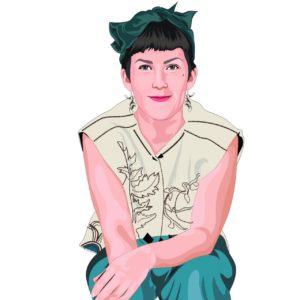 “Catherine Sieck is an amazing artist whose work enthralls me. Her delicate paper cuts must take hours upon hours of painstaking labor. I have spent way too much time trying to decipher the narratives that play out in each piece.”
“Catherine Sieck is an amazing artist whose work enthralls me. Her delicate paper cuts must take hours upon hours of painstaking labor. I have spent way too much time trying to decipher the narratives that play out in each piece.”
Sieck’s work can be seen at catherinesieck.com. Using only her imagination and a sharp blade, the Santa Rosan cuts out remarkably layered portraits and folk-tale depictions far more complex than the technique would suggest. Each one is an original. She also creates shadow puppetry and murals that can be seen throughout Sonoma.
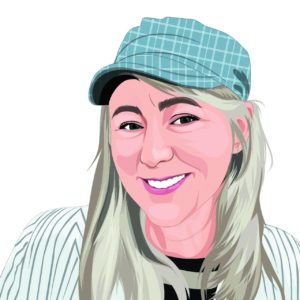 “Theresa Hughes of Dorothea Couture (would be an) interesting dining partner. Her handmade wedding dresses and accessories are mind-blowing. I would love to be a fly on the wall at her studio as she hand-stitches each pleat and tuck.” Hughes’ custom wedding dresses and restored and restyled pre-owned gowns have made her a much-soughtafter buddy of brides to be. Working in a small Santa Rosa shop, she and her team do everything by hand, from dresses to veils to headpieces. She also has a line of silk cover-ups intended for wearing at chilly evening receptions. Her own wedding, to David Farish, “was an all day and night affair,” Hughes said. “We had a blast, but I was exhausted and went to bed long before my guests.”
“Theresa Hughes of Dorothea Couture (would be an) interesting dining partner. Her handmade wedding dresses and accessories are mind-blowing. I would love to be a fly on the wall at her studio as she hand-stitches each pleat and tuck.” Hughes’ custom wedding dresses and restored and restyled pre-owned gowns have made her a much-soughtafter buddy of brides to be. Working in a small Santa Rosa shop, she and her team do everything by hand, from dresses to veils to headpieces. She also has a line of silk cover-ups intended for wearing at chilly evening receptions. Her own wedding, to David Farish, “was an all day and night affair,” Hughes said. “We had a blast, but I was exhausted and went to bed long before my guests.”
The post Who Are Your Dream Sonoma County Dinner Guests? appeared first on Sonoma Magazine.
]]>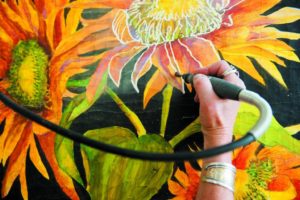
Whether Roberta Ahrens creates a panoramic mural or an 8-by-8-foot painted canvas, her work is never diminutive. Nature speaks to her in a loud voice, and she translates that inspiration into paintings that are lifelike yet unique. She paints cherubs on ceilings, and lilies, poppies and peonies on cracked linen, bringing vibrancy and boldness to […]
The post Petaluma Painter Roberta Ahrens: The Wall is Her Canvas appeared first on Sonoma Magazine.
]]>
















Whether Roberta Ahrens creates a panoramic mural or an 8-by-8-foot painted canvas, her work is never diminutive. Nature speaks to her in a loud voice, and she translates that inspiration into paintings that are lifelike yet unique. She paints cherubs on ceilings, and lilies, poppies and peonies on cracked linen, bringing vibrancy and boldness to the walls and canvases that meet her brush stroke.
Ahrens expertly transforms a painted wall into one that appears to be old wood or adobe. She can turn a ceiling into a wispy, cloud-filled sky. She created a 9-by-12-foot canvas full of flowers and covered it with a protective varnish so it could be used as a carpet under a dining room table. And when a client lamented the view of a drab utility building outside her kitchen window, Ahrens created the trompe l’oeil of a chicken coop complete with realistically rendered hens and a rooster.
While she has transformed many private homes with her decorative painting, Ahrens’ work can also be seen in public spaces, including Ferrari-Carano winery in Healdsburg and Sunflower Caffé in Sonoma. At Ferrari-Carano, she was commissioned by Rhonda Carano to paint a high-domed ceiling in the corporate villa, and murals of rolling hills
Wand rows of Italian cypress trees in the private tasting room.
“It’s tough to paint murals when you’re high up on scaffolding, because you can’t see what it is going to look like,” Ahrens said. So she uses a trick she learned early in her career: view the painting through the back end of binoculars, achieving a sense of distance.
At Sunflower Caffé, she painted six massive panels of sunflowers that cover the entire wall behind the long counter. They are hung like tapestries, not glued to the wall, so they can someday be taken down and hung elsewhere. Sunflower owner James Hahn profusely praises Ahrens’ work.
“You can express your vision to her and not only does she grasp your idea, she adds her creative expertise and gives you exactly what you wanted,” he said. “She is an amazing artist but also a savvy business professional. We’re opening another restaurant, and Roberta will definitely be on the design team.” Her work will be displayed on Sunflower’s walls during January and February, the second time she has been represented in the cafe’s ongoing, revolving art shows.
“I am a master finisher in my profession, but it has taken a while for me to think of myself as an emerging artist,” Ahrens said.
She invented her own signature painting surface, troweling several layers of white plaster onto linen canvas, letting it dry and then rolling it, causing it to crack.
“I’ve really gotten it down to perfection now,” Ahrens said of the technique. The resulting canvas is “tough and slightly thirsty.”
She works in both acrylics and watercolors. After applying the paint to the cracked canvas, she often manipulates it, using sanding and carving techniques. She then glues the canvas to a box frame or backs it with silk or other fabrics so it can be hung tapestry-style. Sometimes her work is glued directly onto the wall.
Ahrens’ paintings have been sold at several galleries and are currently shown at Bluebird Gallery in Laguna Beach and Living Green in San Francisco. She participates twice a year in art fairs at Glasshoff Sculpture Ranch in Fairfield, which she describes as a “very hush-hush event” that nevertheless draws about 3,000 art enthusiasts. She sold eight large pieces to collectors there in the past year. “It’s a new audience for me that’s turning into true success,” she said.
Another first for Ahrens was painting on a nearly 6-foot-tall fiberglass rabbit for the “We Know Jack” fundraiser for the Vacaville Museum. She painted it black and covered it with California poppies. The winning bidder was Assemblyman Jim Frazier, who placed it in his Sacramento office.
A three-series set of amaryllis and poppies can be found on allposters.com, her one allowance for mass production of her work.
“It’s not a big moneymaker for me, but to know my work is hanging nationally, or maybe globally, … makes me happy,” she said of the exposure that comes from online sales.
Ahrens describes the majority of her work as “large-scale botanicals.” She tries to capture the “architecture of nature” in her work, and her canvas itself is part of her work’s allure. Not surprisingly, real sunflowers tower in the front and back gardens of her Petaluma home, where the carefully tended blooms, strawberries and tomatoes of summer fuel her artistic soul all year long.
Although she has no formal art training, Ahrens said she was always the kid at school who could be found in the art room. She was raised in Oregon and followed her older sister, Shelley Masters, to San Francisco. An established master finisher, Masters took on her sister as an apprentice, and paved the way for her entrée to decorative painting.
Ahrens perfected her skills on the job with Evans & Brown, a San Francisco mural and wall-covering firm. She traveled nationwide, applying decorative techniques in shopping malls, hotels and corporate entryways before setting off on her own. Her work appears at the Wynn and Encore hotels in Las Vegas, the Palm Resort in Dubai, and the Four Seasons Maui.
To help market her home-decorative painting niche, Ahrens has a permanent installation of 4-foot sample boards hanging in Peterson’s Paints store in Petaluma, displaying an array of faux finishes; a binder at the counter gives details on each technique and the colors used. While decorative painting is her mainstay, Ahrens said she is thrilled to be part of the team working on the decor of The Petaluman, a boutique hotel scheduled to open in downtown Petaluma this year. And her commissioned work continues to lead her in new directions. An architect hired her to do paintings on cracked linen, a finish his clients admire, but because they love simplicity, there were no flowers this time — just one massive piece in textured white and a second that is entirely black.
“With no imagery, you can really see the cracks,” Ahrens said. “I definitely want to dive in and explore this minimalist idea more.”
Sunflower Caffé, 421 First St. W., Sonoma, 707-996-6645, sonomasunflower.com
Peterson’s Paints, 800 Lindberg Lane, Suite 140, Petaluma, 707-763-1901, petersonspaint.com
The post Petaluma Painter Roberta Ahrens: The Wall is Her Canvas appeared first on Sonoma Magazine.
]]>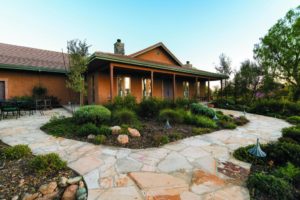
When Fred and Barbara White Perry purchased 4 acres that were once part of the historic Buena Vista Winery, established in 1857, they felt a huge responsibility to honor the land. Located inside the Buena Vista gate and with a view through the trees to Bartholomew Park Winery, they can imagine Agoston Haraszthy, the original […]
The post A Sonoma Home Founded on History and Art appeared first on Sonoma Magazine.
]]>
















When Fred and Barbara White Perry purchased 4 acres that were once part of the historic Buena Vista Winery, established in 1857, they felt a huge responsibility to honor the land. Located inside the Buena Vista gate and with a view through the trees to Bartholomew Park Winery, they can imagine Agoston Haraszthy, the original owner of both wineries and vineyards, still wandering their rows of Zinfandel.
In 1996, the couple had been living for 10 years in a two story home Barbara designed on Sonoma Mountain, where they enjoyed riding their horses. They’d tired of living in the hills and were searching for flat land closer to the heart of things near Sonoma Plaza, where they could build a home with no stairs. Buena Vista’s ownership was transitioning yet again at the time, and when they heard a small piece of the estate was for sale, with vines planted by acclaimed viticulturist Anne Moller-Racke in the early 1980s, they snatched it.
Barbara, an artist and architectural designer, began rendering the plans for their new home by hand, starting out by sitting for hours in the rain, diagramming the natural flow of water on their future home site. She planned the home to the minutest detail, building an architectural model — a step usually reserved for large commercial properties. Even the home’s color palette was decided at the model phase (the exterior stucco is painted the exact color of a rock found on the property). Barbara’s blueprints were stamped with the county’s permit approval on Valentine’s Day 1997, a sign that this home they now cherish would become part of their ongoing love story.
The couple spent hours siting the home’s front door, standing on ladders and taking photos, eventually deciding on the perfect view. A 12-foot-deep veranda with pillars runs the width of the house, a subtle historical reference to Haraszthy’s original villa.
Barbara’s second design inspiration came from an old, wooden, three-gabled farmhouse on Arnold Drive. She had long admired the slowly deteriorating structure and photographed it in 1984. Their home now has three gables, just like the farmhouse did until it was bulldozed in 2001.
The farmhouse was also important to Barbara because it was one of the sparks that led to her publishing her book, “Drawing Sonoma,” which was released in late 2015 and is now in its second printing. The book is a collection of 45 of her ink and vine charcoal drawings of historic and unique properties in Sonoma Valley. The three-gabled farmhouse appears in the section titled, “Gone But Not Forgotten,” where iconic structures no longer standing are captured.
When building a home, most people consider how many heads on pillows they want to accommodate, but for Barbara and Fred, it was all about art on walls. Longtime collectors, particularly of notable Sonoma artists, their goal was to make the interior perfect for showing art. Barbara plotted all the windows so that there was room in between for canvases, and integrated lighting in the 9-foot ceilings to shine at the perfect angle to illuminate paintings. At the center of the residence is a long gallery wall with ample room for the 11 paintings that hang there.
Above the living room fireplace is a Dennis Ziemienski painting, the largest piece in their collection. They also have two Keith Wicks oils, one depicting Spain Street West and the other The Corner Store on the plaza, both purchased at Sonoma’s Plein Air Festival in 2009. There are three Brigitte McReynolds pastels, and commissioned Cynthia Hipkiss clay sculptures of Fred and Barbara riding horses while sipping sparkling wine, with a little sign that reads, “Here’s to 40 Years of Happy Trails.” The “40” is a Post-it, as Barbara updates the number on each wedding anniversary.
In the entry hall are three Jim Callahan bronze sculptures, “Golden Girl,” “Unbridled” and “Sisyphus,” a surprise gift from Fred to Barbara. He placed it on a ledge near the front door and waited until she noticed it. She was thrilled when it caught her eye a few days later.
They also buy art on their vacations, with many pieces acquired at galleries in Carmel. They see something they like, then discuss the possible purchase at dinner over a glass of wine. “We joke later about whether it was a one-glass or two glass decision,” Barbara said. Their home has a trussed roof, which means fewer weight bearing walls are required, making it open and airy. The clean lines encourage a certain ease and sense of calm. Simple, well-designed furniture seems to fade away so the art can reign. The doorways are 3 feet wide with a flat saddle for ease of movement, and the flooring throughout is 12-inch, off-white porcelain tile that has a sheen, which Barbara said makes it easy to keep pristine. She was the general contractor for the project, and the goal in the material choices she made was to keep the home low-maintenance.
Behind the 2,900-square-foot, three-bedroom home (a master suite, guest bedroom and an office for Fred, an expert in cyber security) is Barbara’s artist studio, where she paints almost every day. While the White Perrys collect other Sonoma artists, including Claudia Wager and Brennie Bracket, there are many who collect Barbara’s work. She has been painting since she was a young girl in rural Illinois, studied at the Chicago Art Institute, and was honored as Sonoma’s “Treasure Artist” in 2015.
There is a garden patio between the home and the studio, and an additional outdoor eating area off the dining room, giving two alfresco options no matter which way the wind is blowing. Three acres of vineyards completely surround the home.
Fred and Barbara are philanthropically inclined, and have held many nonprofit fundraisers on their property, often with Fred preparing all the food. They particularly enjoy contributing to Sonoma’s Pets Lifeline, where they found their adorable dog, Benny, a Jack Russell-West Highland white terrier mix. They have a long association with the Sonoma League for Historic Preservation, and are proud that their property won the League’s Preservation Award in 1999 for “new construction compatible with and sensitive to existing historic structures or sites.”
As their home is just a stroll away from Buena Vista’s stone press house, built by Haraszthy in 1863, it’s indeed quite an accomplishment.
The post A Sonoma Home Founded on History and Art appeared first on Sonoma Magazine.
]]>